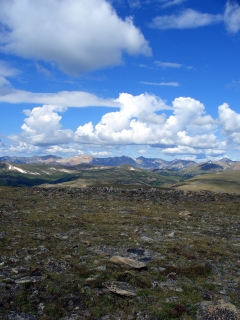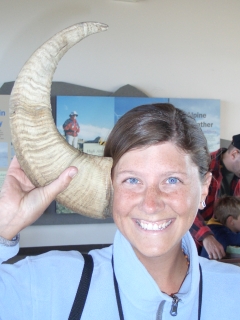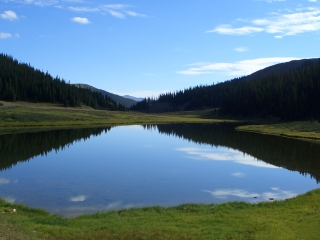NPS Website; Local Website
WHAT IS IT?
A vast expanse of awe-inspiring high-country mountain wilderness highlighted by largest and most accessible tundra ecosystem in the continental United States.
 BEAUTY (10/10)
BEAUTY (10/10)At Rocky Mountain NP, you are on top of the world. Nothing spoils the view, not ski slopes, telephone lines or gondolas. The valley below seems to go on forever the jagged peaks of the Rockies never stop. The tundra wildflowers are so tiny, so colorful and so precious. Waddling rock ptarmigan and blue grouse are apparent only to the quickest eyes while Elk graze conspicuously along the mountainsides oblivious to the gawking human. The thin air makes breathing difficult and the setting’s uniqueness fully apparent.
Down below, the land is a subalpine paradise of green meadows, quaking aspen, mountain streams and reflecting lakes. At all times and from all angles, the Rockies surround. You are always in their shadow, you are in their world.
HISTORICAL INTEREST (2/10)
Rocky Mountain became our country’s tenth National Park in 1915 and an International Biosphere Reserve in 1976. One-armed naturalist and famed Colorado River runner John Wesley Powell was the first man to climb the Park’s treacherous Long’s Peak.
CROWDS (3/10)
Last August, large crowds resulting in no available campsites caused us to delay our trip into Rocky Mountain NP. That was a bad logistical decision because this year we were rushed and did not have the time to escape into the backcountry.
Get to the Park’s western side if you want to avoid the crowds and do not want to go backcountry with the black bears. The scenery is comparable to the east with about 1/10 of the people. The road in the East from Estes Park to Bear Lake so packed with cars that the Park runs a shuttle service. The shuttle does not alleviate the parking problems. The hikes around Emerald Lake, Dream Lake and Nymph Lake were so packed we turned around.
Our most disturbing crowd experience was in the Park’s most beautiful and most fragile ecosystem, the tundra. Numerous couples trudged over the delicate arctic flowers and grasses, ignoring the countless posted signs and basic common sense. We were aghast as one young couple allowed their son to urinate at numerous spots along the trail. We treasure the small glimpse into the world of the tundra and cannot understand why so many people would treat the land with such disregard and disrespect.
 EASE OF USE/ACCESS (4/5)
EASE OF USE/ACCESS (4/5)Rocky Mountain NP is the star attraction of the Denver metropolis’ unmatched environmental backyard. Two U.S. Routes, 34 and 36, lead to the Park’s eastern gateway town, Estes Park. Route 34 comes from the north and passes through Loveland before meeting I-25 at Exit 257 just 35 miles from Estes Park. Route 36 comes from the southeast and is only 35 miles from the near perfect town of Boulder. Downtown Denver is just 25 more miles southeast down Route 36.
It is remarkable that an International Biosphere Reserve is so close to so many people. The Park’s Trail Ridge Road is the highest continuous paved road in the United States, its apex reaching a challenging 12,183 feet. The nearby Tundra Communities Trail allows easy (if your lungs can take it) access to a high altitude ecosystem rarely seen by anyone except mountain climbers. Keep your eyes open for rock ptarmigan, hoary marmots and picas; the average person rarely gets a chance to see these mostly Arctic animals.
CONCESSIONS/BOOKSTORE (3/5)
Underwhelming selection for a mega-park. The Rocky Mountain National Park Tricky Trails Game tempted us, especially because of it darling animal game pieces. We also chuckled at the stuffed moose wearing an oxygen mask at the Alpine Visitor Center (elev. 11,796 feet).
COSTS (1/5)
Rocky Mountain costs $20 per vehicle, free with the National Parks Pass. Campsites run a steep $20 per space.
RANGER/GUIDE TO TOURIST RATIO (5/5)
The Park has six Visitor Centers including one at each of the Park’s four entrances. Numerous Rangers staff them all. We happened onto Ranger talks at Moraine Park and Kawuneechee and had a pleasant conversation with a Ranger looking for a reported forest fire at an overlook.
At Alpine, we started a show with our line of Ranger questioning. Before we knew what had happened, one Ranger was trumpeting rutting elk calls into a rolled up poster while another nearly caused a riot by pointing out a soaring juvenile golden Eagle. Michael was so excited about the Eagle and the Ranger’s suggestion for finding rock ptarmigan (successful!) that he forgot to ask where to see the Rocky Mountain Big Horn Sheep, his favorite animal. Had he asked, we would have gone to the nearby Milner Pass. Oh well.
TOURS/CLASSES (8/10)
We found a terrific new film on a big screen TV at the Beaver Meadows VC, great new tundra-related displays at the Alpine VC and fun new exhibits at the Moraine Park Museum. Gab especially enjoyed Moraine Park’s “Bend a Rock!” and “Be a Glacier” interactive tests. Is there anything this Park does not do well? The glacier display especially helped out understanding of what a glacier does, how it carves and how it is different from a snowfield.
The Ranger talk at Kawuneechee was fun partly because we got to handle ram’s horns, moose antlers and elk hooves but mostly because of the inquisitive and attentive crowd of young listeners. One future dentist was unyielding in his questions, “Do elk have teeth? How many teeth?” Ten minutes later, “How sharp are mountain lions’ teeth? How many teeth do they have? Have they ever killed anyone?” Yes, but actually no was the Ranger’s response. “Huh?” we all wondered.
We are unsure if the crowd appreciated the resulting story; a range of disturbed emotions covered their faces during the retelling. A young boy was hiking more than a 1/2 mile ahead of his parents and was eating candy while walking. A mountain lion appeared out of nowhere. The boy choked on the food and died instantly. The lion dragged him off and enjoyed an easily hunted meal. The lion was exterminated even though it didn’t really cause the initial injury. Plenty of lessons to be learned from that story, kids.
 FUN (8/10)
FUN (8/10)Rocky Mountain NP feels like a place of lost opportunities. We regret not having enough time to plan an extended trek. We wish that we had more time to explore the subalpine lakes and we really wanted to see Big Horn Sheep. Still, the tundra was incredible, our campsite sublime, although the trumpeting elk sounded awful close to our tent. Maybe we will just have to move the greater Denver area in order to enjoy Rocky Mountain NP to its fullest.
WOULD WE RECOMMEND? (9/10)
This is your best place to see the tundra unless you are traveling to Alaska’s northern tier or Green Bay’s Lambeau Field in January. The Park’s mountains feel like the only peaks in Colorado free from the ski industry. Enjoy this special place while you can and remember to ask a Ranger where you can spot the Big Horn Sheep.
TOTAL 53/80
www.usa-c2c.com
© 2005